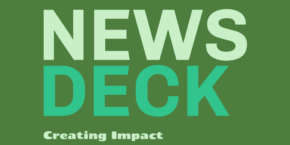4. Stimulating the curiosity of the participants and broadening horizons in STEP 1
In the “medium- to long-term understanding improvement” of STEP 1, we held a dialogue between the management team and experts as well as lectures related to the theme of initiatives linked to medium-term management issues.



5. Broadening horizons and perspectives and deriving an action plan in STEP 2
In the team activities of STEP 2, the roughly 130 participants were divided into 27 teams to form pseudo-management teams. Each team spent about three months on a “future vision story” that deepens their insight into the world and verbalizes and visualizes the future and an “action plan” that connects that vision to Murata's business challenges and proposes specific measures.
 .
.
Takami: “We set the final briefing session for proposing the action plan to the management team as the goal, but we emphasized the process of dialogue across the organization with members who possess various ideas and values over the content of the plan. Many teams struggled with stepping away from their normal duties, finding out what they want to do from scratch, and reconciling those ideas within the team.”
Nishida: “We collected action plans based on various themes such as the environment and regional revitalization as well as the era of 100-year life spans, etc., and proposals were made to the management team at the final briefing session. Some members of the management team praised the novel themes while others expressed the opinion that they were still weak from a business challenge standpoint. I think that the full participation by the management team and a frank exchange of opinions was a great experience for the participants.”
Mikuma: “Starting from STEP 2, we had the departmental managers participate as mentors. Monthly meetings in which the mentors would give advice to the participants were held, and the participants received advice from angles they could not see alone.”


Matsumura from the Human Resource Development Department
Nishida: “A unique feature of the 'future vision stories' was that we had the participants set aside Murata as a topic and asked them to fantasize about the world and society from their own viewpoints and ideas. In STEP 2, one important outcome was the strengthening of not only horizontal but also vertical and external ties.”
6. Clarifying the leadership image to aim for and continuing to take on challenges in daily work in STEP 3
In the “leadership image clarification” of STEP 3, we established opportunities for the participants to look at their own careers and have a dialogue about leadership image.
Mikuma: “The aim of STEP 3 was to clarify the leadership image to aim for and connect that to action within one's daily work through one-on-one meetings between the participants and the departmental managers in charge of development and dialogue within the teams.”
Nishida: “Opportunities were also established for the participants to engage in dialogue with the management team and their mentors. The mentors also encouraged the participants to escape from their comfort zone of familiar methods and extend their hands out until they can barely reach, or in other words to tackle the challenge of working in their stretch zone.”
Mikuma: “The participants commented that the dialogues with the management team and mentors were stimulating, and they were able to resolve their concerns about the leadership image they should aim for. In addition, I think that in STEP 2 and STEP 3, an atmosphere and awareness of honest discussion with the members spread between the participants.”
7. Establishing a climate and culture of human resource development through “Make2030”
After the completion of “Make2030,” the first large-scale training program for Murata, the “atmosphere and awareness of honest discussion” highlighted by Mikuma is an important point, Takami pointed out.
Takami: “This is connected to the point about honest discussion by the participants, but in 'Make2030' I realized once again that individual initiative has a really significant impact on the growth of human resources. That is not the only thing, as it was also important for the people around them to support earnestly that individual initiative.”
Mikuma: “In addition, the meaning of connecting the leadership image to action within one's daily work does not end with 'Make2030' but will continue going forward. I think that the key in the future will be how each person acts and how they involve those around them.”
Matsumura: “I believe that the true results of 'Make2030' will be revealed several years from now. I sincerely hope that the participants open up a path to Murata's future while applying what they learned in 'Make2030' on a daily basis.”
Nishida: “I would like to use the recent 'Make2030' as a starting point to further establish an active culture of human resource development. I think that 'Make2030' has been valuable in terms of providing a meeting place that transcends organizational barriers for the human resources who are responsible for the company's future.”
*Departmental affiliations are as of June 2023.





